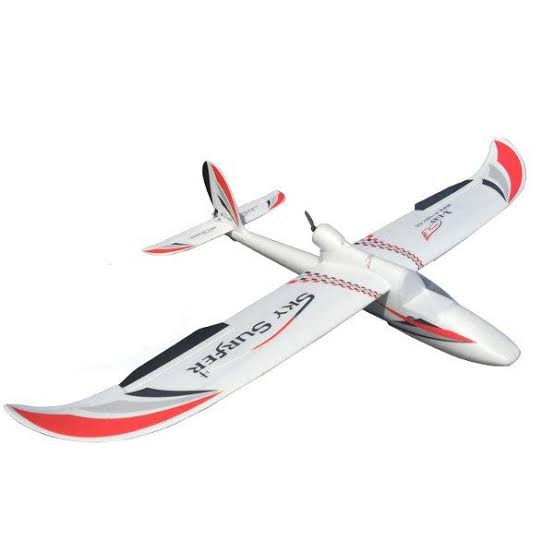Though not critical to the success of our project, one of the functions we were looking to incorporate was the ability to have a live first person video (FPV) view of the airplane.
To achieve this, we require 4 main components:
- Camera (airside)
- Video Transmitter (airside)
- Video receiver (landside)
- Monitor (landside)
Note: The term airside implies that components labelled as such will be on the plane in the air while those marked as landside will remain on the ground at all times.
After doing some research and banking on our previous RC knowledge, we came up with the following list of items to buy from Taobao:
Camera: TOP RC Spotter v2 5.8GHz VTx + Camera

Our camera of choice!
Weighing just 9g, this camera is perfect for a plane with little cargo space like our Skysurfer.
To us, the main selling point was the fact that it was an integrated system: a camera and video transmitter with antenna all in one unit!
Besides saving space, this also means that the wiring job we have to do in order to get the live video feed working is reduced to just providing power to the unit (no need to worry about operating voltage differences between transmitter and camera and figuring out how to manage the rat’s nest of wires between the two aforementioned components)
We opted for the version with the cloverleaf antenna(that mushroom thing sticking out in the picture above) to reduce the likelihood of multipath interference.
Video Transmitter: ….??
As mentioned above, the video transmitter is integrated with the camera, so one less thing to worry about. Next.
Video Receiver: Eachine TS832

Our video receiver of choice
There was no specific reason as to why we chose this model over others, other than the fact that it just works.
Anyway, shortly I began my first tests with the camera, I started wishing that I had gotten a receiver with more frills. More on that later…
Monitor: Taken from MnT Lab
We did not buy a monitor off Taobao as during our first few visits to the lab, we realised that previous batches of PS9888 students bought a handful of monitors, together with spares that were never opened. So in order to save some money, we opted to use those hand-me-downs instead.
The requirement here was simple: all we needed was a monitor that will not display a blue screen (but rather static snow) on signal loss. This is because monitors that blue screen cut out completely when video signal dips below a certain level. As the likelihood of this happening when flying at distance is high, we need a screen that shows snow instead as these will still display a partial picture, giving us a fighting chance at flying our precious model back to safety.

Blue screen bad!

Snow good!
Functionality Test…
After plugging everything in, I realised that there was one simple(but rather serious) problem: I had no idea what channel my glorious video signal was being beamed on! There are tens of channels on the 5.8GHz spectrum so it was quite unrealistic and impractical to cycle through them one by one. It’s quite unfortunate that the RC832 unit we bought did not have auto scanning capabilities.
Seniors to the rescue!
Until I walked to the area behind the MnT lab and noticed sitting in this box this receiver:

“Auto Scan”
Wasting no time, I set it up immediately and in no time, it automatically tuned to the correct channel, and was even kind enough to tell me what channel it was on!

Press the CH and FR buttons simultaneously and hey presto! Auto scan initialises!
Knowing the exact channel of the FPV transmitter, I could now tune our RC832 using the lookup table provided by the manufacturer.
Everything works but…
Knowing that everything worked was a good sign. However, the lack of an auto scanning function mean that we had to use the Quanum receiver bought by our seniors. However, another problem ensued: the FPV camera/transmitter we purchased came only with a cloverleaf antenna soldered on, whereas the Quanum Receiver only came with inferior rubber ducky antennas. It’s not ideal mixing both types of antennas as that would reduce our video link range significantly.

FPV Camera with antenna soldered on
Although we bought extra cloverleaf antennas, we intended for them to be used with the RC832 only – which used RP-SMA connectors. The Quanum receiver uses SMA connectors. Bummer!

SMA on the seniors’ receiver

RP-SMA on the receiver we bought
Although leaving everything on one channel and not touching it afterwards would be the ideal scenario, this is unrealistic as we would be doing weekend flying and Old Holland Road – one of Singapore’s few designated drone flying zones – meaning that the area will be jam packed with other hobbyists doing FPV flying. It is quite likely that we will have to change frequencies in order to avoid interference (and crashing as a result)
With that, we figured that the best compromise to bring both receivers: the Quanum to verify the channel that the camera is on, and then tune to that frequency on the RC832.

























